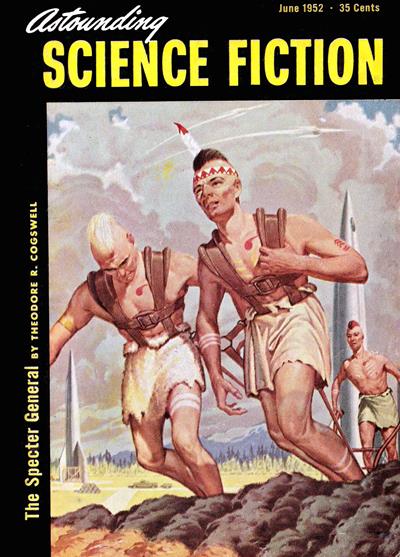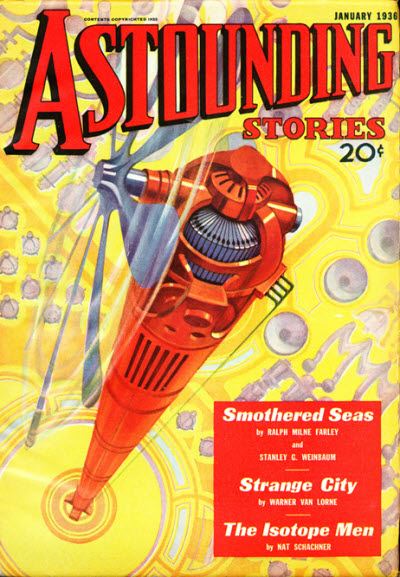
Part of Series
Vol 21, No 2. Contents: 4 • In Times to Come (Astounding, April 1938) • [In Times to Come (Astounding)] • essay by The Editor 6 • Three Thousand Years! (Part 1 of 3) • serial by Thomas Calvert McClary (book publication as Three Thousand Years 1954) 27 • Matter Is Conserved • short story by Raymond A. Palmer 38 • Of the 500 Known Elements • essay by uncredited 39 • Hyperpilosity • short story by L. Sprague de Camp (variant of Hyperpelosity) 48 • Negative Space • novelette by Nat Schachner 78 • The Faithful • short story by Lester del Rey 85 • Detail—But Immensely Important to Engineering • essay by John W. Campbell, Jr. [as by uncredited] 86 • Iszt—Earthman • novelette by Raymond Z. Gallun 116 • Radiation in Uniform • essay by Herbert C. McKay 125 • Democracy • [Editorial (Astounding)] • essay by The Editor 126 • Jason Sows Again (Part 2 of 2) • serial by Arthur J. Burks 149 • Ignition Point • essay by John W. Campbell, Jr. [as by Arthur McCann] 151 • Science Discussions and Brass Tacks (Astounding, April 1938) • [Brass Tacks] • essay by The Editor 151 • Letters. First edition here. 【 PREVIOUS ISSUE ← April 1938 → NEXT ISSUE 】
Authors




Aka William Callahan, Arthur Allport. Raymond Zinke Gallun (March 22, 1911 - April 2, 1994) was an early science fiction writer. Gallun (rhymes with "balloon") was born in Beaver Dam, Wisconsin. He lived a drifter's existence, working a multitude of jobs around the world in the years leading up to World War II. He sold many popular stories to pulp magazines in the 1930s. "Old Faithful" (1934) was his first noted story. "The Gentle Brain" was published in "Science Fiction Quarterly" under the pseudonym Arthur Allport. Another of his pseudonyms was William Callahan.

Raymond Arthur Palmer, also known as Raymond Alfred Palmer, and Ray Palmer. He was the influential editor of Amazing Stories from 1938 through 1949, when he left publisher Ziff-Davis to publish and edit Fate Magazine, and eventually many other magazines and books through his own publishing houses, including Amherst Press and Palmer Publications. In addition to magazines such as Mystic, Search, and 'Flying Saucers," he published numerous spirtualist books, including Oahspe: A New Bible, as well as several books related to flying saucers, including "The Coming of the Saucers," co-written by Palmer with Kenneth Arnold. Palmer was also a prolific author of science fiction and fantasy stories, many of which were published under pseudonyms. According to Bruce Lanier Wright, "Palmer was hit by a truck at age seven and suffered a broken back." An unsuccessful operation on Palmer's spine stunted his growth (he stood about four feet tall), and left him with a hunchback. Palmer found refuge in science fiction, which he read voraciously. He rose through the ranks of science fiction fandom and is credited, along with Walter Dennis, with editing the first fanzine, The Comet, in May, 1930. Ziff-Davis acquired Amazing Stories in 1938. The publisher sacked then editor T. O'Conor Sloane and, on the recommendation of popular author Ralph Milne Farley, offered the editorship to Palmer. In 1939, Palmer began a companion magazine to Amazing Stories titled Fantastic Adventures, which lasted until 1953. When Ziff-Davis moved its magazine production from Chicago to New York City in 1949, Palmer resigned and, with Curtis Fuller, another Ziff-Davis editor who did not want to leave the Midwest, founded Clark Publishing Co. As an editor, Palmer tended to favour adventurous, fast-moving space opera-type stories. His tenure at Amazing Stories was notable for his purchase of Isaac Asimov's first professional story, "Marooned Off Vesta". Palmer was also known for his support of the long running and controversial Shaver Mystery stories, a series of stories by Richard S. Shaver. Palmer's support of the truth of Shaver's stories (which maintained that the world is dominated by insane inhabitants of the hollow earth), was controversial in the science fiction community. It is unclear whether Palmer believed the Shaver stories to be true, or if he was just using the stories to sell magazines. Palmer began his own science fiction publishing ventures while working for Ziff-Davis, eventually leaving the company to form his own publishing house, Clark Publishing Company, which was responsible for the titles Imagination and Other Worlds, among others. None of these magazines achieved the success of Amazing Stories during the Palmer years, but Palmer published Space World magazine until his death. In 1948, Palmer and Curtis Fuller co-founded Fate, which covered divination methods, Fortean events, belief in the survival of personality after death, predictive dreams, accounts of ghosts, mental telepathy, archaeology, flying saucer sightings, cryptozoology, alternative medicine, warnings of death, and other paranormal topics, many contributed by readers. Curtis Fuller and his wife Mary took full control of Fate in 1955, when Palmer sold his interest in the venture. The magazine has continued in publication under a series of editors and publishers to the present day. Another paranormal magazine Palmer created along the line of Fate was Mystic magazine, which after about two years of publication became Search magazine. In the 1970s, Palmer also published Ray Palmer's News Letter which was combined into another of his publications called Forum in March 1975. In the first issue of Fate, Palmer published Kenneth Arnold's report of "flying discs." Arnold's sighting marked the beginning of the modern UFO era, and his story propelled the fledgling Fate to national recognition. Through Fate, Palmer was instrumental in popularizing belief in fl

Lester del Rey was an American science fiction author and editor. Del Rey is especially famous for his juvenile novels such as those which are part of the Winston Science Fiction series, and for Del Rey Books, the fantasy and science fiction branch of Ballantine Books edited by Lester del Rey and his fourth wife Judy-Lynn del Rey. Also published as: Philip St. John Eric van Lihn Erik van Lhin Kenneth Wright Edson McCann (with Frederik Pohl)


